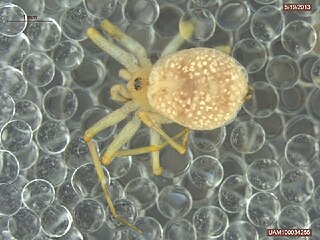
Huntsman spiders, members of the family Sparassidae, are known by this name because of their speed and mode of hunting. They are also called giant crab spiders because of their size and appearance. Larger species sometimes are referred to as wood spiders, because of their preference for woody places. In southern Africa the genus Palystes are known as rain spiders or lizard-eating spiders. Commonly they are confused with baboon spiders from the Mygalomorphae infraorder, which are not closely related.

Theridiidae, also known as the tangle-web spiders, cobweb spiders and comb-footed spiders, is a large family of araneomorph spiders first described by Carl Jakob Sundevall in 1833. This diverse, globally distributed family includes over 3,000 species in 124 genera, and is the most common arthropod found in human dwellings throughout the world.

The Pholcidae are a family of araneomorph spiders. The family contains over 1,800 pholcids, including those commonly known as the marbled cellar spider , daddy long-legs spider, granddaddy long-legs spider, carpenter spider, daddy long-legger, vibrating spider, gyrating spider, long daddy, and skull spider. The family, first described by Carl Ludwig Koch in 1850, is divided into 94 genera.
Tidarren sisyphoides is a spider of the family Theridiidae.

The hawthorn shield bug is a common European shield bug. Its chief food is haws, the fruit of the hawthorn tree, but adults can overwinter on a diet of leaves, and individuals can be found on many potential food plants, including pedunculate oak, sessile oak and whitebeam. They may grow up to 17 mm (0.67 in) long, and are camouflaged in shades of green and brown. Like many so-called "stink bugs", they may release unpleasant odours when disturbed.

Lasioderma is a genus of beetles in the family Ptinidae. As of 1990, there were over 50 species in the genus.

Spiders are air-breathing arthropods that have eight legs, chelicerae with fangs generally able to inject venom, and spinnerets that extrude silk. They are the largest order of arachnids and rank seventh in total species diversity among all orders of organisms. Spiders are found worldwide on every continent except for Antarctica, and have become established in nearly every habitat with the exceptions of air and sea colonization. As of July 2019, at least 48,200 spider species, and 120 families have been recorded by taxonomists. However, there has been dissension within the scientific community as to how all these families should be classified, as evidenced by the over 20 different classifications that have been proposed since 1900.
Tidarren argo is a spider from Yemen. The species is remarkable by its male amputating one of its palps before maturation and entering his adult life with one palp only. It adopts exceptional copulatory behaviour: when the male achieves genitalia coupling with his palp, the latter is torn off by the female. The separated gonopod remains attached to the female's epigynum for approximately 4 hours and continues to function independently, serving as a mating plug. While this happens, the female feeds on the male. Emasculation thus synchronizes sexual cannibalism and sperm transfer, lengthening the interval between copulations. This mating behaviour might allow for the continuation of insemination by the dismembered palp.
Echinotheridion is a genus of comb-footed spiders that was first described by Herbert Walter Levi in 1963.
Castianeira occidens is a species of true spider in the family Corinnidae. It is found in the United States and Mexico.

Phidippus carneus is a species of jumping spider in the family Salticidae. It is found in the United States and Mexico.

Cybaeota shastae is a species of true spider in the family Cybaeidae. It is found in the United States.

Hypochilus coylei is a species of lampshade weaver in the family of spiders known as Hypochilidae. It is found in the United States. This species inhabits a 35 mile north-south corridor of mountain range in western North Carolina. This species has a two year life cycle and feeds on crickets and spiders.
Linyphantes pualla is a species of sheetweb spider in the family Linyphiidae. It is found in the United States and Canada.

Oecobius cellariorum is a species of wall spider in the family Oecobiidae. It is found in a range from Southern Europe to North Africa, Jordan and Iran, has been introduced into the United States, China, and Japan.

Pimoa altioculata is a species of true spider in the family Pimoidae. It is found in the United States and Canada.
Pholcophora americana is a species of cellar spider in the family Pholcidae. It is found in the United States and Canada.
Orodrassus canadensis is a species of ground spider in the family Gnaphosidae. It is found in the United States and Canada.

Castianeira gertschi, the Gertsch antmimic, is a species of true spider in the family Corinnidae. It is found in the United States and Canada.
Cryptorhopalum haemorrhoidale is a species of carpet beetle in the family Dermestidae. It is found in North America.











